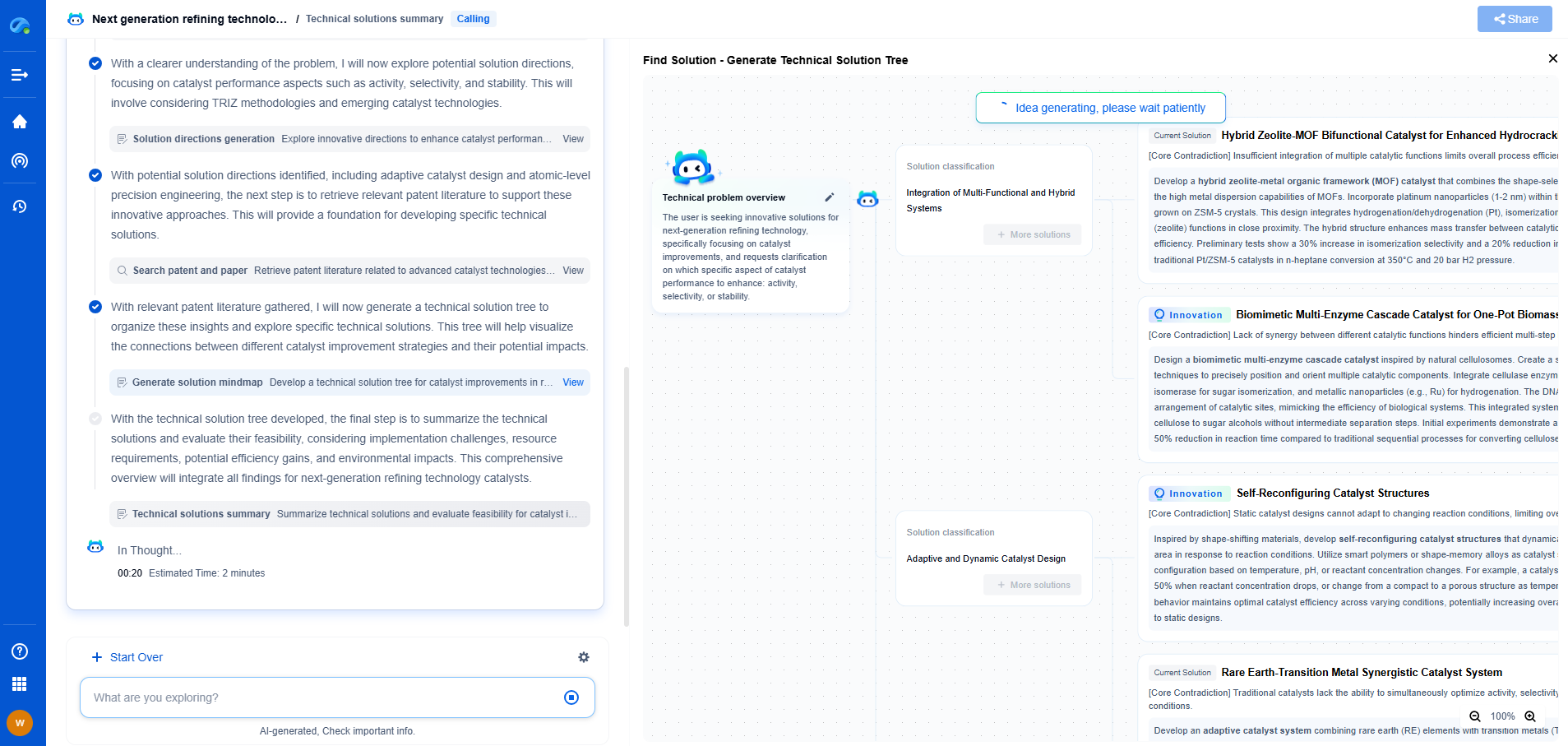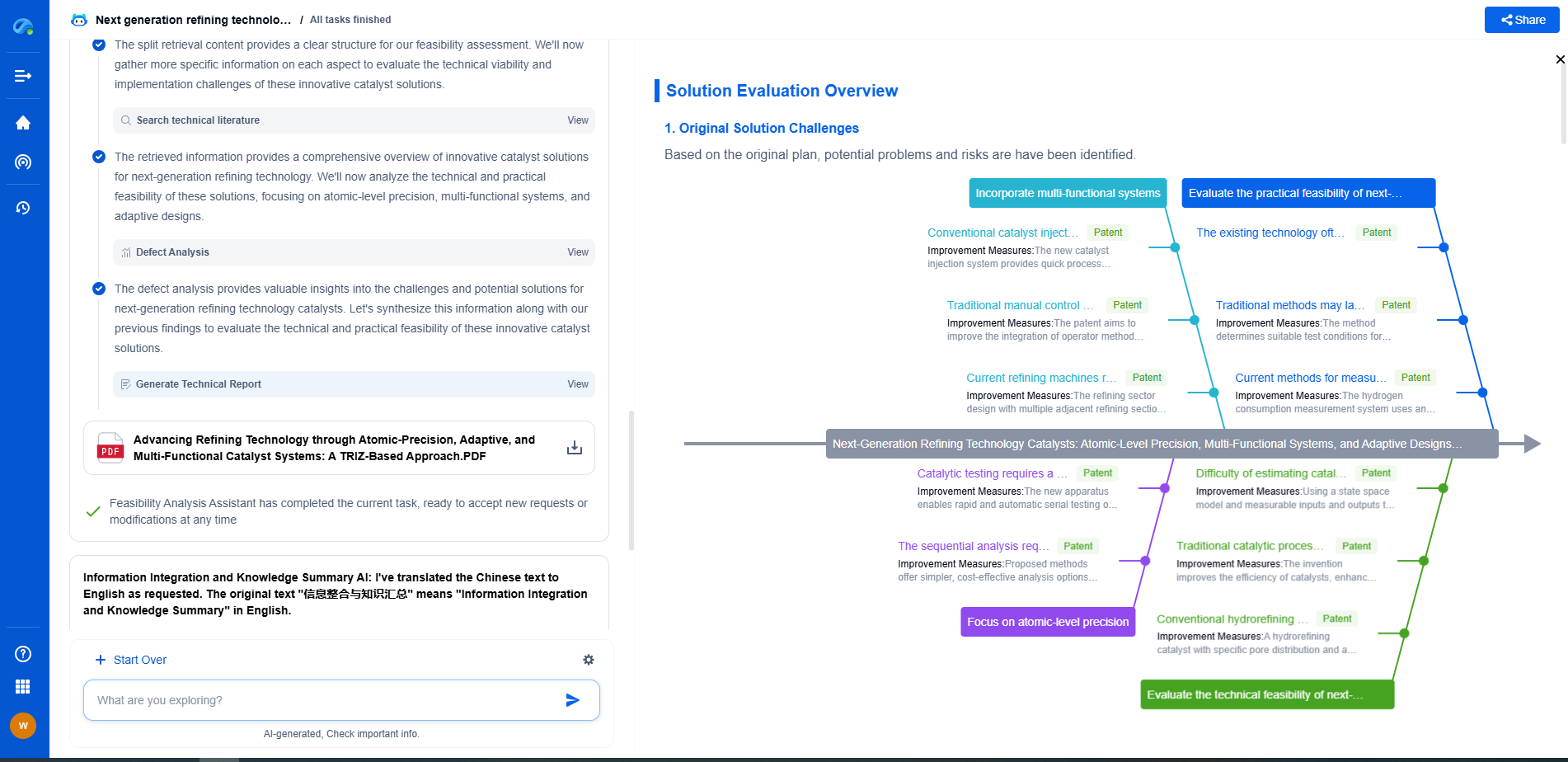Clutch Mechanism Design: Friction Materials, Springs & Engagement Strategies
JUL 2, 2025 |
The design of a clutch mechanism is a critical aspect of automotive and machinery engineering. It involves a delicate balance of components that work together to regulate the transfer of torque from the engine to the drivetrain. Understanding the intricate details of friction materials, spring dynamics, and engagement strategies is essential for creating a reliable and efficient clutch system. In this comprehensive exploration, we will delve into these key elements and their roles in clutch mechanism design.
Friction Materials: The Heart of the Clutch
Friction materials are at the core of clutch operation. They are tasked with maintaining grip between the clutch disc and the flywheel, facilitating smooth engagement and disengagement. The choice of friction material can profoundly impact clutch performance, durability, and cost.
Organic friction materials, made from a blend of resin and fibers, are commonly used in passenger vehicles due to their smooth engagement characteristics and cost-effectiveness. However, they tend to wear out faster under high-performance conditions. Sintered metal friction materials, on the other hand, offer exceptional durability and are favored in high-performance and heavy-duty applications. They can withstand extreme temperatures and high loads but may result in harsher engagement.
Ceramic friction materials strike a balance between organic and sintered metals. They provide excellent heat resistance and durability, making them ideal for performance vehicles that require quick shifts and prolonged use. Understanding the specific demands of the vehicle or machinery is crucial in selecting the appropriate friction material to ensure optimal performance and longevity.
Springs: Balancing Force and Engagement
Springs in a clutch mechanism play a vital role in controlling engagement force and maintaining pressure on the friction surfaces. The design and selection of springs directly affect how the clutch engages and disengages, influencing both the driver’s experience and the system’s durability.
Diaphragm springs are widely used due to their ability to provide a consistent engagement force over a wide range of motion. They are compact and efficient, making them suitable for most passenger vehicles. Coil springs, though less common, are utilized in some applications where higher clamping forces are required. They offer versatility in tuning engagement characteristics but can result in more complex designs.
The spring rate and preload are critical factors in clutch design. A higher spring rate means greater force is required to disengage the clutch, which can enhance torque capacity but may lead to a heavier pedal feel. Conversely, a lower spring rate might improve comfort but sacrifice performance under load. Engineers must carefully balance these parameters to align with the intended application, whether it’s for everyday comfort or high-performance agility.
Engagement Strategies: Ensuring Smooth Transitions
Engagement strategies refer to the methods used to initiate and control clutch interaction between the engine and the transmission. A seamless engagement strategy is essential for maintaining the integrity of the drivetrain and delivering a pleasant driving experience.
There are two primary types of engagement strategies: mechanical and hydraulic. Mechanical clutches rely on a direct link between the pedal and the clutch mechanism, often resulting in a more tactile and predictable feel. However, they may require more effort from the driver, which can be tiring over long periods.
Hydraulic clutches use fluid pressure to actuate the clutch mechanism, offering a lighter pedal feel and often smoother engagement. They are self-adjusting, which reduces maintenance needs but can be more complex and costly to repair.
The choice of engagement strategy often depends on the vehicle type and intended use. Performance vehicles might prioritize precise mechanical feedback, while luxury vehicles aim for effortless hydraulic operation. Engineers must weigh these factors and consider user experience and reliability when designing the clutch system.
Conclusion
The design of a clutch mechanism is an intricate process that involves the careful selection of friction materials, springs, and engagement strategies. Each component must be meticulously engineered to meet the demands of specific applications, balancing performance, durability, and user comfort. By understanding the roles and interactions of these elements, engineers can create clutch systems that enhance vehicle performance and deliver a superior driving experience. Whether for everyday commuting or high-performance racing, the right clutch design is pivotal in ensuring the seamless transfer of power and maintaining the integrity of the drivetrain.
Boost Innovation in Gears & Transmissions with Patsnap Eureka
Whether you're designing a next-gen planetary gearbox or optimizing gear tooth profiles for noise reduction, keeping up with the fast-evolving landscape of mechanical transmissions requires more than just experience—it takes insight, speed, and smart tools.
Patsnap Eureka, our intelligent AI assistant built for R&D professionals in high-tech sectors, empowers you with real-time expert-level analysis, technology roadmap exploration, and strategic mapping of core patents—all within a seamless, user-friendly interface.
Whether you're streamlining a manual transmission system or exploring electromechanical actuation, Patsnap Eureka helps your team move from concept to novelty faster than ever.
👉 Experience Eureka in action—request a personalized demo today and see how AI can revolutionize your gear innovation workflows.
- R&D
- Intellectual Property
- Life Sciences
- Materials
- Tech Scout
- Unparalleled Data Quality
- Higher Quality Content
- 60% Fewer Hallucinations
Browse by: Latest US Patents, China's latest patents, Technical Efficacy Thesaurus, Application Domain, Technology Topic, Popular Technical Reports.
© 2025 PatSnap. All rights reserved.Legal|Privacy policy|Modern Slavery Act Transparency Statement|Sitemap|About US| Contact US: help@patsnap.com

